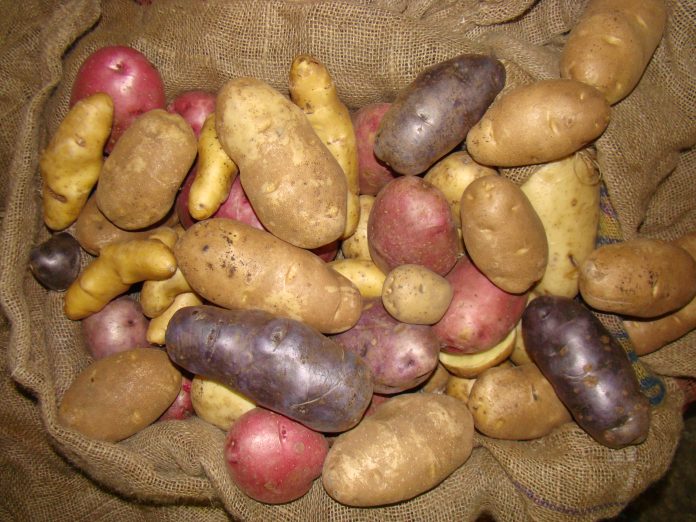Jackie Bantle
Potatoes are one of the easiest and most rewarding vegetable crops to grow on the Prairies. For each small seed tuber planted in the ground, a harvest of 5-10 tubers (depending on the cultivar) is typical. No two potato cultivars are alike. Every type of potato or cultivar has been bred for a particular purpose: boiling potatoes don’t necessarily fry well and baking potatoes don’t necessarily boil well.
Potato cultivars recommended for boiling usually have interior flesh with a high water content and waxy texture: these qualities ensure that they don’t turn ‘mushy’ during the boiling process. ‘Norland’ and ‘Viking’ are red skinned, white fleshed, oval potatoes recommended for boiling. Both cultivars are early maturing, however ‘Viking’ tends to produce larger and fewer tubers than ‘Norland’. Both cultivars have moderate resistance to potato scab. ‘Sangre’ is a dark red-skinned, white fleshed, oval potato recommended for boiling. ‘Sangre’ matures slightly later in the season than ‘Norland or ‘Viking’ and is more susceptible to scab than Norland or Viking. ‘AC Peregrine’ is a dark red-skinned, white fleshed oval potato recommended for boiling. ‘AC Peregrine’ matures late in the season but it has an excellent tuber set. Tubers do not tend to oversize.
Two purple skinned, white fleshed potato cultivars that are recommended for boiling are: ‘Purple Viking’ and ‘Caribe’. ‘Purple Viking’ is slightly later maturing than ‘Viking’ or ‘Norland’ and tubers tend to oversize. ‘Caribe’ is similar to ‘Purple Viking’ except that the tubers tend to be more flattened in shape than ‘Purple Viking’. Caribe is also more sensitive to common scab than ‘Purple Viking’.
Several white/yellow skinned and yellow fleshed potato cultivars that are recommended for boiling include ‘Bintje’ and ‘Yukon Gold’. ‘Bintje’ is a small-medium sized, oval potato with excellent flavour. ‘Yukon Gold’ tubers mature earlier and are larger than ‘Bintje’, however ‘Yukon Gold’ is more susceptible to potato scab than ‘Bintje’. Both cultivars are also recommended for baking and frying. ‘Shepody’ is an excellent, white-skinned, all-purpose potato (boiling, frying or baking) that matures early in season. If left in the garden until the end of the season, tubers can become quite large and sometimes have hollow centres.
One of the best tasting white/yellow skinned potatoes with yellow flesh is ‘Milva’. This potato has excellent yields, matures in mid-late season and is excellent for boiling. ‘Milva’ potato seed can be difficult to source.
Potato cultivars that are recommended for baking have a higher level of solids in their flesh, resulting in a firm dry texture after baking. Potatoes with russet skins are usually recommended for baking. ‘Russet Burbank’, ‘Russet Norkotah’, ‘Goldrush’, ‘Ranger Russet’ and ‘Umatilla Russet’ are all off-white fleshed, oblong potatoes recommended for baking and French frying. Of these five cultivars, ‘Russet Norkotah’ has the most uniform sized tubers however, the taste is probably the least favorable. ‘Russet Burbank’ is the latest maturing. If growing conditions are not ideal, ‘Russet Burbank’ tends to produce knobby and hollow tubers. All russet potato cultivars are fairly resistant to scab infection.
Potato cultivars recommended for frying or chipping have a high percentage of solids in their flesh and low sugar content. The high solid content ensures the potatoes will stay crisp after frying while the low sugar content prevents the potatoes from becoming too dark when fried. ‘Kennebec’ is a later maturing cultivar that is recommended for frying but also performs well when boiled or baked. ‘Kennebec’ is moderately susceptible to scab infections.
Many gardeners try to get an early start by planting their potato tubers outdoors early in May. This is not recommended as the soil can be quite cool at that time of the year. Cool soil conditions encourage potato seed tuber rot and a disease on potatoes known as rhizoctonia. Rhizoctonia looks like specs of dirt on the potato skin but this so-called ‘dirt’ doesn’t wash off. This fungal disease, Rhizoctonia solani, can reduce yields and even kill plants, if the infection is severe enough.
Avoid rhizoctonia infection by planting clean seed and planting into warm soil (at least 15°C). An alternative to early spring planting is GREENSPROUTING your potato tubers. Place your potato seed tubers under bright light conditions at room temperature about 3 weeks prior to planting out. Short, green sprouts will form on the potato tubers. Once soil has warmed up, plant potato tubers in the ground as you normally would: take care not to break off the developing sprouts. By planting these pre-sprouted potato seed tubers into warm soil (3rd – 4th week in May), plants will emerge quickly and disease incidence will be minimized.
Jackie Bantle is a horticulturist working in the Dept. Of Plant Sciences, University of Saskatchewan. This column is provided courtesy of the Saskatchewan Perennial Society (SPS; saskperennial@hotmail.com ). Upcoming event – Spring Plant and Seed Exchange and Plant Sale Tuesday May 30th 6:30pm at Saskatoon Forestry and Zoo Hall. Check our website (www.saskperennial.ca) for more detail.


